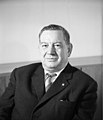1972 Besmenian federal election
| |||||||||||||||||||||||||||||||||||||
427 seats 214 seats needed for a majority | |||||||||||||||||||||||||||||||||||||
|---|---|---|---|---|---|---|---|---|---|---|---|---|---|---|---|---|---|---|---|---|---|---|---|---|---|---|---|---|---|---|---|---|---|---|---|---|---|
| |||||||||||||||||||||||||||||||||||||
File:Besmenia1972electionmap.png Strongest party by state | |||||||||||||||||||||||||||||||||||||
| |||||||||||||||||||||||||||||||||||||
The 1972 Besmenian federal election took place in Besmenia on January 16, 1972. It was the election of the 14th Federal Chamber.
The SDU under Premier Johannes Schmidt lost a lot of votes and after 8 years as the strongest party became the second strongest again. The strongest party was the BVP, which sent its chairman Robert Gleitzmann into the race as the top candidate and benefited from the losses of the SDU. The FBBP and the BRP gained mandates. The DB lost votes and dropped out of the Federal Chamber with 3.3%.
Background
In the 1968 federal election, the first all-Besmenian election in around 50 years, the coalition of the SDU and BVP, which had existed since 1956, was confirmed under Prime Minister Johannes Schmidt.
After Robert Gleitzmann was elected BVP chairman on 31 March, 1969, Schmidt announced the termination the SDU-BVP coalition. Even before that, Gleitzmann had criticized Schmidt's leadership and the economic policy under the SDU-BVP federal government. After talks between the two parties, the BVP decided to leave the government and went into opposition. The BVP members left the government on 10 April. In order not to hold snap elections, the SDU held talks with the FBBP and DB, with the result that the FBBP and DB agreed to support an SDU minority government. Schmidt's third cabinet was inaugurated on 6 May.
Electoral system
Contesting parties
Prime Minister candidate of the parties
BVP
SDU
FBBP
BRP
BELP
DB
Campaign
TV debates
Results
Government formation
- Federal government: 227
- Opposition: 200
| Coalitions considered | Seats |
|---|---|
| Total seats | 427 |
| Absolute majority (From 214 seats) | |
| BVP, SDU | 279 |
| BVP, FBBP | 258 |
| BVP, BRP, BELP | 252 |
| BVP, BRP | 227 |
The coalition negotiations between the BVP and the SDU to extend the government cooperation that had existed since 1956 failed because Schmidt refused to work with Gleitzmann. As a result, the BVP began negotiations with the BRP. On February 24, 1972, the federal government Gleitzmann I, the first blue-orange government, was formed. The participation of the BRP in government triggered strong protests in parts of the Besmenian population and at the diplomatic level.






